Who is the blogger?
Video Trailer Collection
Picks from movies shown on TVOntario's Saturday Night at the Movies
Entries in 1960s films (13)
Georgy Girl (1966)
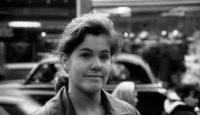 Before there was an “Ugly Betty”, there was “Georgy Girl” (1966). The film lights down in London town during those mad 1960s with the crazy new sounds coming out of bands like “The Seekers” and the even crazier new hairdos and mini skirts. We see Georgy girl (Lynn Redgrave) awkwardly sporting one of the new “dos” as the opening credits roll over top of the chart topping
Before there was an “Ugly Betty”, there was “Georgy Girl” (1966). The film lights down in London town during those mad 1960s with the crazy new sounds coming out of bands like “The Seekers” and the even crazier new hairdos and mini skirts. We see Georgy girl (Lynn Redgrave) awkwardly sporting one of the new “dos” as the opening credits roll over top of the chart topping 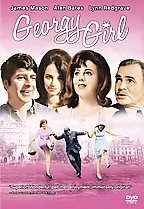 number by the Australian band. (I was surprised to learn that they weren’t a part of the British invasion.) The film is a lot like the title song in that it is a lighthearted romp with surprisingly serious undertones for those who are really listening.
number by the Australian band. (I was surprised to learn that they weren’t a part of the British invasion.) The film is a lot like the title song in that it is a lighthearted romp with surprisingly serious undertones for those who are really listening.
The story line is a bit mixed up, much like Georgy herself. Georgy’s beautiful and free-spirited roommate, Meredith, leaves behind a boyfried and a baby as she gets on with her life after an ever so brief encounter with her own non-maternal nature. Georgy tries to pick up the pieces. After all, there is an adorable, helpless child involved. The make-shift domestic arrangements with Jos, the baby’s father, soon fall apart. A cast-off boyfriend doesn’t really fit any 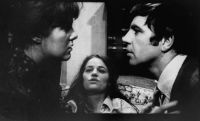 better than the ridiculous coiffure that Georgy tries on in the film’s introduction. In true improvisational style that fits the times and Georgy’s quirky personality, she tries on a completely different set of circumstances by accepting her family’s employer as stand-in dad. James Leamington (played by James Mason) is supposedly Georgy’s better in social standing - although one wonders if he isn’t actually her “worser” after he offers her an albeit “very proper” and attractive contractual arrangement for Georgy to be his mistress. Georgy passes up the offer. She’d like to think she can do better. She changes her mind (like a girl changes clothes) when the offer firms up a bit more and becomes a proposal of marriage after Leamington’s wife conveniently takes herself out of the way by dying.
better than the ridiculous coiffure that Georgy tries on in the film’s introduction. In true improvisational style that fits the times and Georgy’s quirky personality, she tries on a completely different set of circumstances by accepting her family’s employer as stand-in dad. James Leamington (played by James Mason) is supposedly Georgy’s better in social standing - although one wonders if he isn’t actually her “worser” after he offers her an albeit “very proper” and attractive contractual arrangement for Georgy to be his mistress. Georgy passes up the offer. She’d like to think she can do better. She changes her mind (like a girl changes clothes) when the offer firms up a bit more and becomes a proposal of marriage after Leamington’s wife conveniently takes herself out of the way by dying.
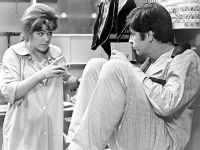 In the end, it is a marriage of convenience that Georgy chooses as her best fit in the era of the sexual revolution. It is perhaps the best option afforded to someone like Georgy “who just missed being beautiful”. One wonders how well this arrangement is going to work out over time, as we watch the closing scene where the new bride repeatedly caresses her adopted infant. She seems oblivious to the groom sitting next to her in the get away car. It may well end up as just another failed experiment to be washed away down the drain along with the hair pins and mascara of Georgy’s “new look” in the opening scene.
In the end, it is a marriage of convenience that Georgy chooses as her best fit in the era of the sexual revolution. It is perhaps the best option afforded to someone like Georgy “who just missed being beautiful”. One wonders how well this arrangement is going to work out over time, as we watch the closing scene where the new bride repeatedly caresses her adopted infant. She seems oblivious to the groom sitting next to her in the get away car. It may well end up as just another failed experiment to be washed away down the drain along with the hair pins and mascara of Georgy’s “new look” in the opening scene.
Georgy’s pick of the best offer out of a limited range of options appears to be missing something: unconditional commitment and acceptance of people for who they really are. It’s what Georgy really wants; it’s what all of us want in the end –free love.
Don’t miss the SNAM Interviews on the subject of “Beauty -and Other Myths”. The Interviews deal extensively with another movie with a parallel theme shown in conjunction with “Georgy Girl” The second feature was “Dogfight”.
>>Real Life: Michelle participated in “The Biggest Loser” contest in order to lose weight. She found unexpected healing that led to a more permanent change in her life.
>>More to see: Looking for more out of life?
See the TVO video trailer for "Georgy Girl" (1966)
The Spy Who Came in from the Cold (1965)
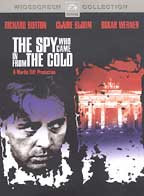 In “The Spy Who Came In From The Cold” (1965), John le Carré’s influential novel of cold war espionage comes to life with Richard Burton playing the central character. Alec Leamas is a far cry from the super suave super-spy, James Bond. There’s none of the gadgetry and high gloss finish for the ordinary agent Leamas who gets to visit such exotic destinations as a forest hut, a cement cell
In “The Spy Who Came In From The Cold” (1965), John le Carré’s influential novel of cold war espionage comes to life with Richard Burton playing the central character. Alec Leamas is a far cry from the super suave super-spy, James Bond. There’s none of the gadgetry and high gloss finish for the ordinary agent Leamas who gets to visit such exotic destinations as a forest hut, a cement cell  and an austere courtroom in nowhere town, East Germany thanks to his exciting chosen profession as a spy. The enduring points of interest from the film (and the novel) do not come from glamourous locations, steamy sex scenes or fantastic special effects that accompany the adrenalin pumping pursuits of the secret agent. This black and white film features things that are a little more low key (not to mention low budget). Complex dialogue, interesting character development and moral dilemma
and an austere courtroom in nowhere town, East Germany thanks to his exciting chosen profession as a spy. The enduring points of interest from the film (and the novel) do not come from glamourous locations, steamy sex scenes or fantastic special effects that accompany the adrenalin pumping pursuits of the secret agent. This black and white film features things that are a little more low key (not to mention low budget). Complex dialogue, interesting character development and moral dilemma  sustain one’s attention and actually leave one with something to think about after it’s all over. Move Mr. Bond. No matter what worthy actor they get to play the eternally youthful 007, he won’t be a match for Burton’s rather gritty Alec Leamas à la le Carré.
sustain one’s attention and actually leave one with something to think about after it’s all over. Move Mr. Bond. No matter what worthy actor they get to play the eternally youthful 007, he won’t be a match for Burton’s rather gritty Alec Leamas à la le Carré.
See a very interesting SNAM “Interview” that includes material on John le Carré’s spy novels. “The Deadly Affair" (1966), screened on the same evening on Saturday Night at the Movies is also reviewed on Midnight Oil.
You can try listening to the original novel on audiobook.
>>More to see: Looking for more out of life?
>>Real Life Story: Priscilla escaped oppression while living in an Eastern block country under Communist rule.
See the trailer for "The Spy Who Came in from the Cold" (1965)
Fahrenheit 451 (1966)
 "Fahrenheit 451" (1966) IMDb, inspired by Ray Bradbury's science fiction novel of the same name, delivers a disturbing vision of a futuristic world where books are contraband to be burned by the state. For those of us who love books, this is a truly scary and undesirable future reality. Werner Oskar stars
"Fahrenheit 451" (1966) IMDb, inspired by Ray Bradbury's science fiction novel of the same name, delivers a disturbing vision of a futuristic world where books are contraband to be burned by the state. For those of us who love books, this is a truly scary and undesirable future reality. Werner Oskar stars  as the fireman who begins to question the purpose behind burning books in the oppressive police state. Julie Christie plays the double role of the witless wife of the fireman, Linda, and the open minded free spirit, Clarisse.
as the fireman who begins to question the purpose behind burning books in the oppressive police state. Julie Christie plays the double role of the witless wife of the fireman, Linda, and the open minded free spirit, Clarisse.
Check out Thom Ernst's blog for the scoop on his interview with the original author, Ray Bradbury, for the TVO Saturday Night at the Movies Interviews.
 View the TVO video web preview for "Fahrenheit 451" (includes snippets of the Bradbury interview)
View the TVO video web preview for "Fahrenheit 451" (includes snippets of the Bradbury interview)
<<Back to Midnight Oil main journal
>>On to "Who's Directing Your Life?"
See the video trailer for "Fahrenheit 451" (1966)
The List of Adrian Messenger (1963)
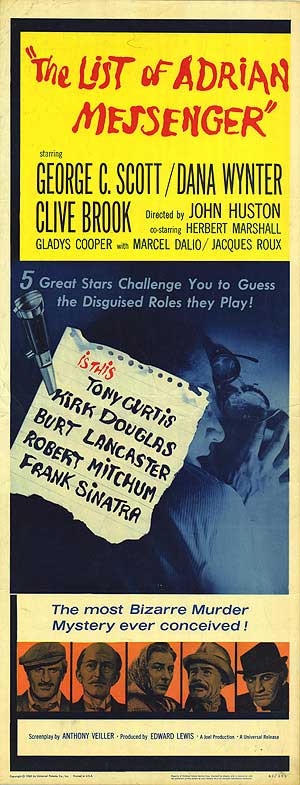 “The List of Adrian Messenger” (1963) a film directed by John Ford, produces an interesting mystery and an even more interesting list of cameo character appearances by famous Hollywood stars of the day. The premise of the film has a semi-retired MI6 officer, George C. Scott, investigating the whereabouts of a puzzling list of men who appear to have all gone missing. Kirk Douglas pops up throughout the film, eventually revealing himself to be one George Brougham, a long lost son who re-emerges from the Colonies (a.k.a Canada).
“The List of Adrian Messenger” (1963) a film directed by John Ford, produces an interesting mystery and an even more interesting list of cameo character appearances by famous Hollywood stars of the day. The premise of the film has a semi-retired MI6 officer, George C. Scott, investigating the whereabouts of a puzzling list of men who appear to have all gone missing. Kirk Douglas pops up throughout the film, eventually revealing himself to be one George Brougham, a long lost son who re-emerges from the Colonies (a.k.a Canada).
A fox hunt and a manhunt ensue. Will the fox be caught? Will the innocent young heir to the family fortune be spared a gruesome fate? Will his attractive widowed mother end up with the right suitor? All is set right in the end and the villain is “unmasked”.
But what really kept my interest the first time I saw the film on SNAM in the wee hours of the 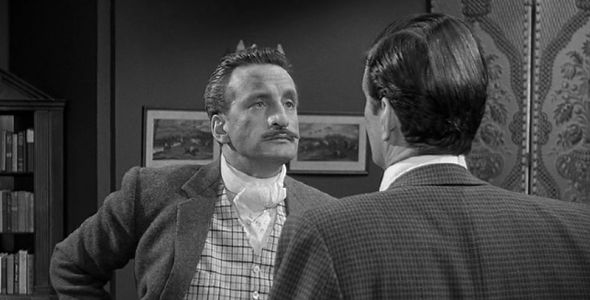 morning many moons ago was the hunt for the Hollywood stars. I just couldn’t figure out how you could manage to get Frank Sinatra, Tony Curtis, Robert Mitchum and Burt Lancaster into this odd little production. The joke was on the audience of course. The ending reveals all!
morning many moons ago was the hunt for the Hollywood stars. I just couldn’t figure out how you could manage to get Frank Sinatra, Tony Curtis, Robert Mitchum and Burt Lancaster into this odd little production. The joke was on the audience of course. The ending reveals all!
<<Back to Midnight Oil main journal
>>On to "Who's Directing Your Life?"
The Deadly Affair (1966)
 In “The Deadly Affair” (1966) IMDb, John le Carré’s spy novel turns into a cinematic adventure for everyday secret service man, Charles Dobbs (played by James Mason). Even though he has a nymphomaniac wife at home, Charles Dobbs’ career as a British intelligence officer is nothing like that of James Bond. A suspicious looking suicide after an apparently unfounded accusation of communist sympathies leads down a trail of cold war intrigue. As the plot thickens, Dobb’s finds the answers in places that strike close uncomfortably close to home.
In “The Deadly Affair” (1966) IMDb, John le Carré’s spy novel turns into a cinematic adventure for everyday secret service man, Charles Dobbs (played by James Mason). Even though he has a nymphomaniac wife at home, Charles Dobbs’ career as a British intelligence officer is nothing like that of James Bond. A suspicious looking suicide after an apparently unfounded accusation of communist sympathies leads down a trail of cold war intrigue. As the plot thickens, Dobb’s finds the answers in places that strike close uncomfortably close to home.
See a very interesting SNAM “Interview” that includes material on John le Carré’s more famous spy novel, “The Spy Who Came in from the Cold”, a film starring Richard Burton, also screened on the same evening on Saturday Night at the Movies.
<<Back to Midnight Oil main journal
>>On to "Who's Directing Your Life?"
Catch the opening credits and opening scene for “The Deadly Affair” (1966) here.





